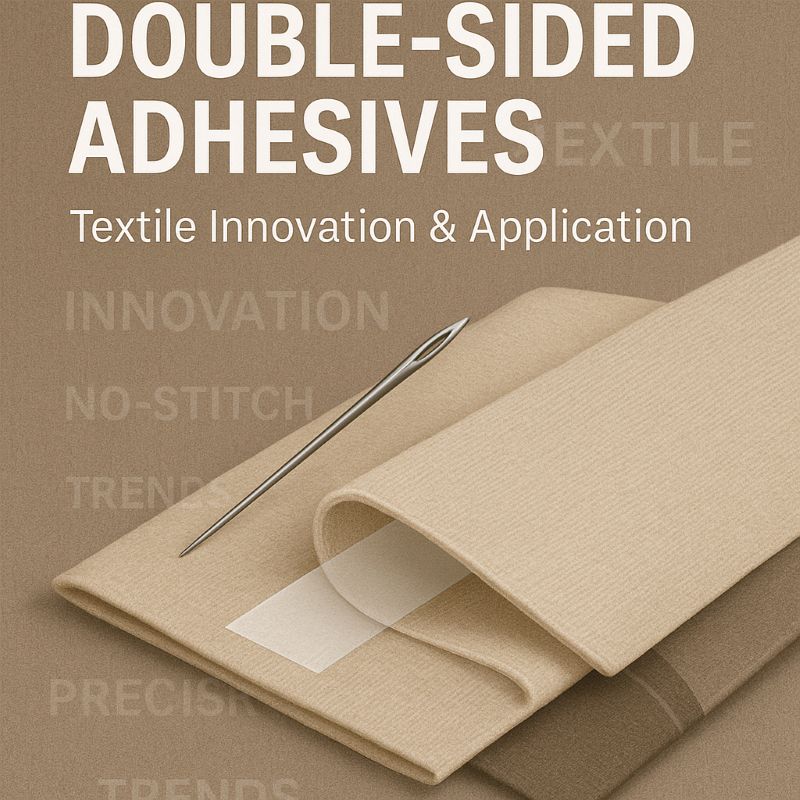
Definition of Double-Sided Adhesive
Types of Double-Sided Adhesives
Importance in Textile Applications
Innovative Usage Methods
Latest Trends in Textile Adhesives
Strategies for Effective Application
Future Prospects in Textile Industry
Frequently Asked Questions (FAQ)
Double-sided adhesive is a flexible bonding material coated on both sides, enabling discreet, seamless attachment between fabrics and other materials. In the textile industry, this type of adhesive allows for cleaner finishes and greater design flexibility by eliminating the need for visible stitching or mechanical fastening.
Double-sided adhesives used in textiles vary by thickness, strength, and intended application:
Foam-type adhesives provide cushioning and are well-suited for bonding fabrics with uneven surfaces.
High-strength tapes are designed for heavier textiles and more demanding bonding environments.
Low-tack or light-duty adhesives are ideal for delicate materials, preserving softness and texture.
Temporary-use tapes support quick fixes, prototyping, or reversible design layouts.
These types enable textile manufacturers to select the most appropriate bonding solution based on fabric type, durability requirements, and project goals.
Double-sided adhesives are reshaping textile design and production. They offer invisible, clean bonds that maintain garment aesthetics while improving production efficiency. For industrial uses, such as uniform construction or technical textiles, they provide long-lasting adhesion without bulk or stitching. In creative design, they allow for layering, embellishing, and experimenting with new textures and silhouettes—all while preserving material integrity.
Textile professionals are leveraging double-sided adhesives in ways that go beyond traditional sewing:
Creating seamless hems without thread.
Bonding decorative elements such as lace, trims, or appliqués.
Attaching technical linings or reinforcing panels in sportswear or outerwear.
Enabling temporary alterations or display samples for design review or fitting.
These applications offer new creative freedom while saving time and labor during production.
Recent trends are redefining the role of adhesives in fashion and technical textile production:
Sustainable adhesive development is addressing the demand for eco-friendly bonding alternatives.
Increased use in heavy-duty textiles supports more durable, wash-resistant garments.
Customizable adhesives are being developed for specific fabric types and garment categories.
Digital pattern integration allows adhesive placement to align precisely with design software outputs.
These innovations contribute to faster prototyping, cleaner garment construction, and environmentally conscious manufacturing.
To ensure successful bonding in textile applications:
Choose the right adhesive type based on the fabric's weight, porosity, and end use.
Make sure surfaces are clean and dry before application.
Apply even pressure to achieve full contact and maximize bond strength.
Consider heat or pressure activation, where applicable, for stronger adhesion.
Conduct adhesion tests before full-scale application to ensure compatibility.
These strategies help manufacturers and designers achieve precise, durable, and repeatable results.
Double-sided adhesives are set to play a pivotal role in the future of textile manufacturing:
They support non-sewn garment construction, reducing labor time and cost.
Their sustainability potential makes them ideal for eco-conscious brands seeking alternatives to stitching or synthetic threads.
Their role in technical and smart textiles is expanding, especially in wearables and sensor-embedded fabrics.
Continuous R&D in pressure-sensitive and heat-activated adhesives will unlock new possibilities for design and production.
As these innovations mature, double-sided adhesives will become a standard tool in both industrial and creative textile processes.
What is a double-sided adhesive?
It’s a bonding material with adhesive on both sides, used to join fabrics or materials without visible stitching or hardware.
What are common types of double-sided adhesives for textiles?
Foam adhesives for cushioning, high-strength variants for heavy fabrics, light-duty adhesives for delicate materials, and temporary-use options for reversible setups.
Why are they important in textile applications?
They provide clean, aesthetic, and durable bonds that simplify manufacturing while preserving design integrity.
How can they be innovatively applied?
They are used for seamless hems, attaching embellishments, supporting layered designs, and prototyping.
What are the latest trends in textile adhesives?
Trends include sustainable adhesive development, high-durability formulations, customization by fabric type, and digital integration.
What strategies ensure successful use?
Proper adhesive selection, surface prep, uniform pressure application, and testing for compatibility.
What’s the future of double-sided adhesives in textiles?
They’re becoming essential tools for sustainable, high-performance, and non-stitched garment production.
Can they support sustainable fashion?
Yes, by reducing sewing, waste, and synthetic thread use, double-sided adhesives align with eco-friendly production goals.